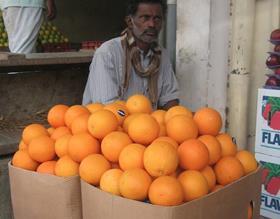
Citrus industry leaders in South Africa have been discussing ways to make the most of the potential that the Indian market offers.
Some feel that joint marketing and branding initiatives is the only answer, and the members of a South African citrus delegation that visited India last week seem to agree with this.
This most recent South African citrus delegation to India says exporters will need to invest time and resources in understanding the Indian market, building networks and educating the supply chain if they aim to exploit the obvious potential.
The delegation met with Indian officials in New Delhi to discuss the review of the in-transit cold treatment that applies to South African citrus shipped to India. The review has been going on for some time and the delegation says it is hoped that the requirements will be reviewed without much more delay. In terms of the review, trial shipments of oranges have been successfully received in India.
“An interesting development is that of private ports in India,” says the Citrus Growers’ Association spokesman, Justin Chadwick. “Presentations from private port operators showed new cold store construction and a focus on the quick clearance and movement of perishable products.”
The delegation says more than 75 per cent of fresh produce is still sold through traditional markets in India. “Modern or ‘organised’ retail is still small,” the delegation noted.
“This is important to understand when forming a marketing and distribution strategy for India. Exporters who are serious about the Indian market need to visit the country in person – no amount of reading or being briefed can replace personal experience. It is a market like no other,” Chadwick continues.
A visit to a high-end retailer in Mumbai, similar to Woolworths in South Africa, was very interesting, according to Chadwick. “It was concerning that labelling on the shelves was at odds with the fruit stickers. Grapefruit with Egypt stickers was labelled as 'Product of the USA', while Egyptian Valencia’s were labelled as 'Product of South Africa'.”
The South Africans were clearly not impressed with the answers they received.
Chadwick says it was explained that product changed from week to week and sometimes they (the supermarket) were slow in changing the shelf labels. “This seems a tall story given that South African Valencia’s would have last been shipped to India in November 2018.
“This was a high end retailer – and yet the fresh produce was of a very poor quality. A lot of the produce would not be found in any store in South Africa.”
Despite this, the prices were exorbitantly high. The Egyptian grapefruit (labelled US fruit) was selling at US$17.33 per kg (US$30 per 15kg carton); Egyptian Valencia (labelled as South African) was selling for US$2.9 per kg or US$43.5 per 15 Kg carton. This is at a time when the same carton was selling for under US$8 in the market.
Chadwick says this indicates clearly that demand is going to be poor at these sorts of prices and there are huge margins being made between wholesale and retail.



